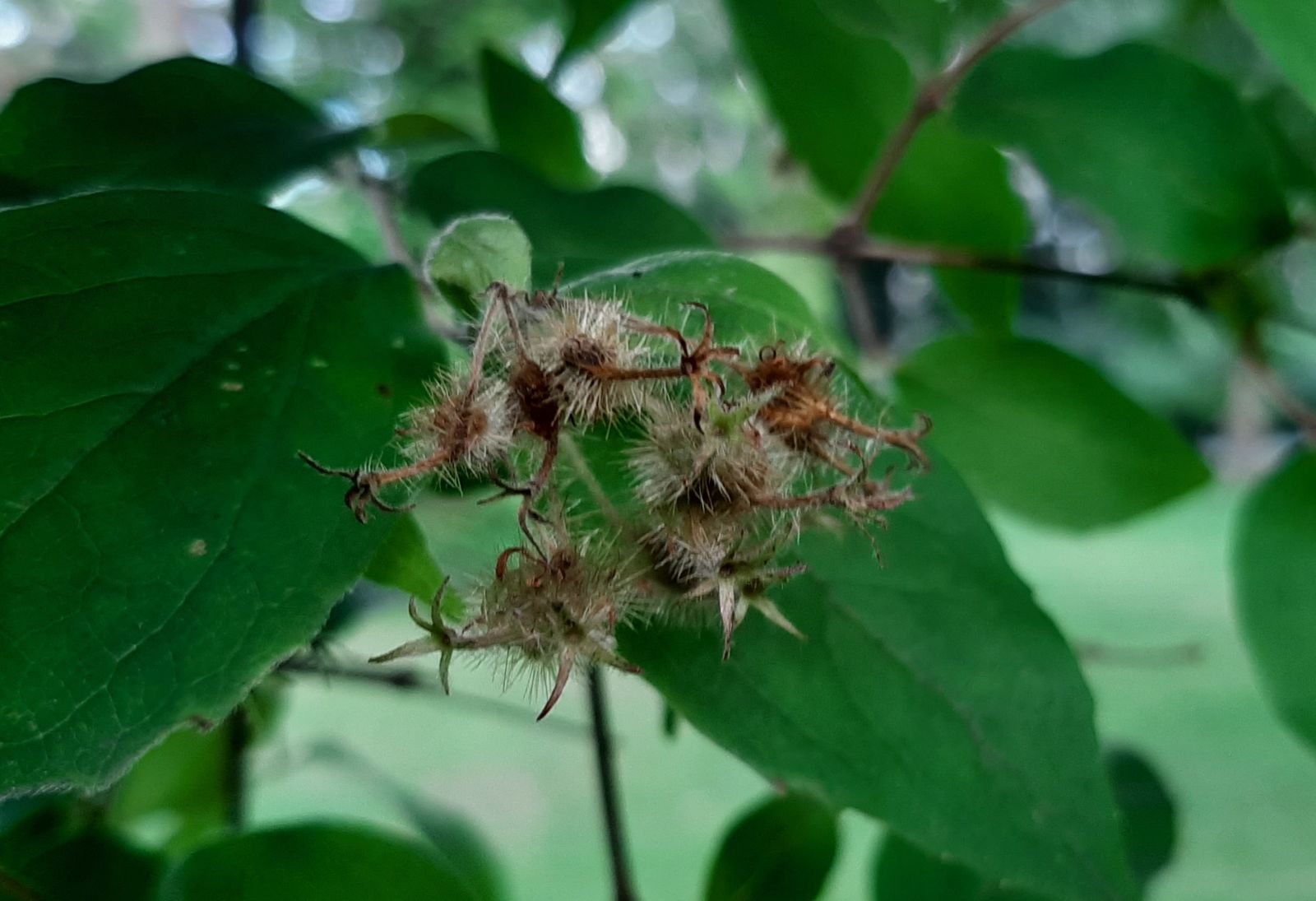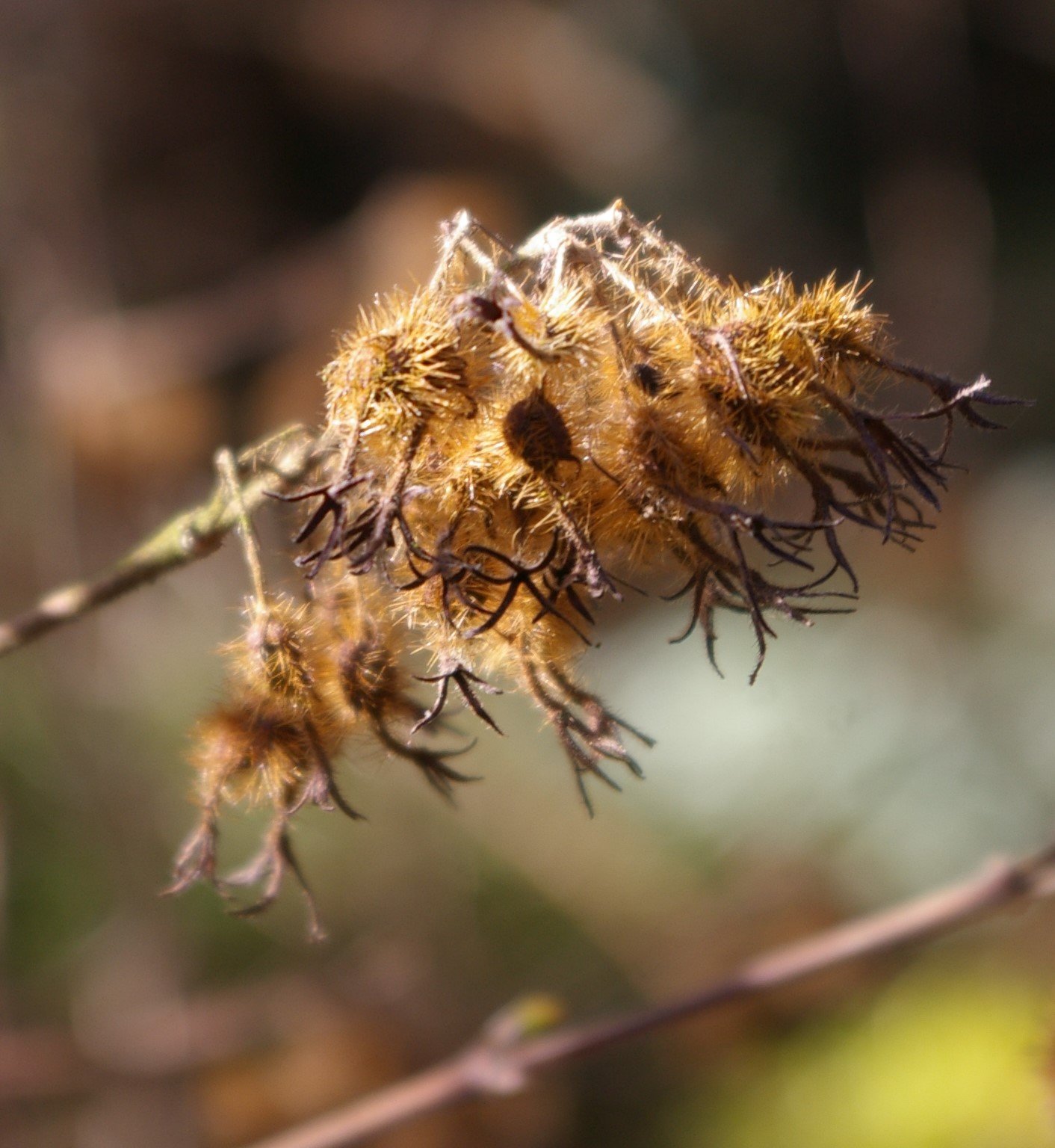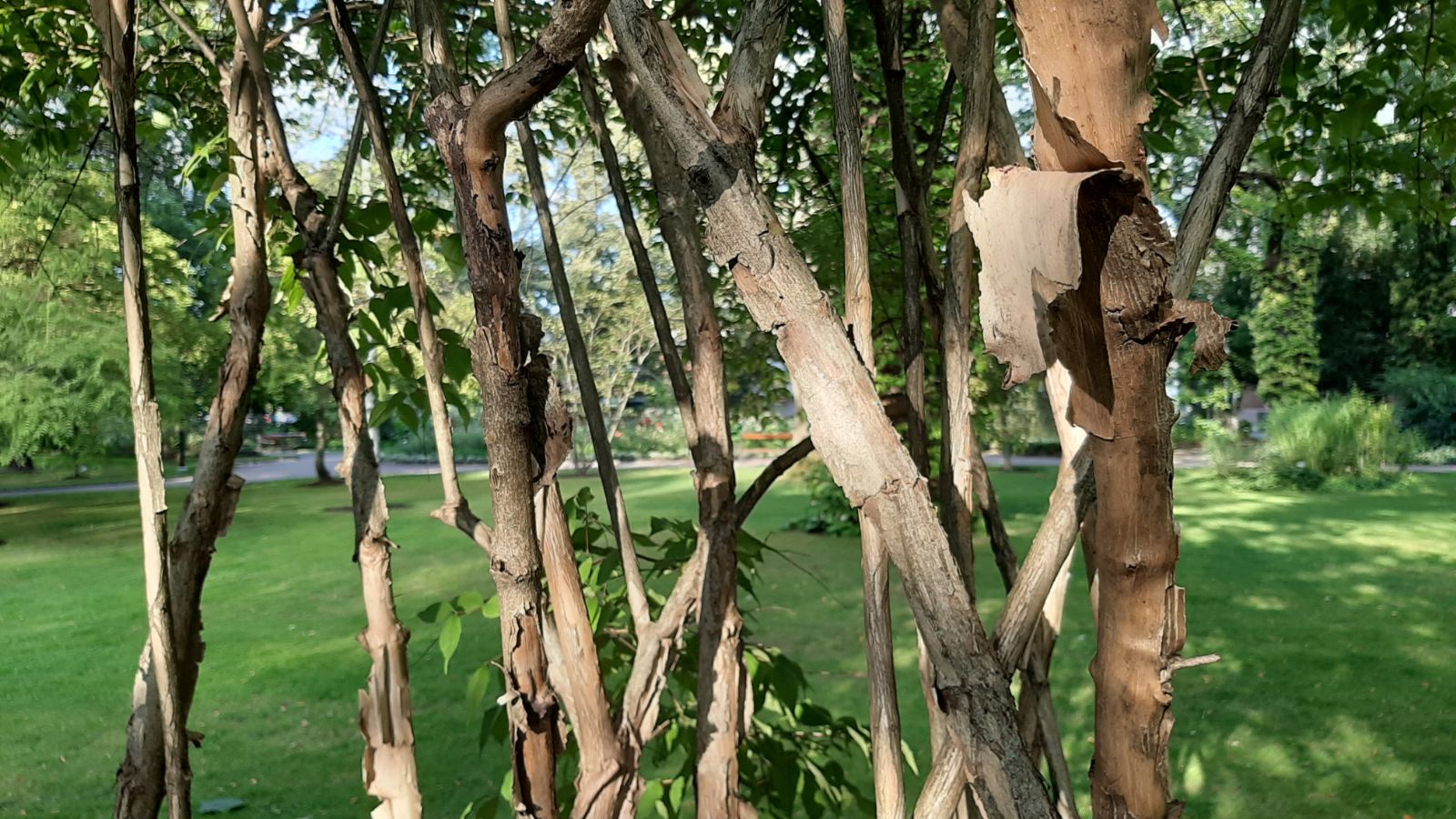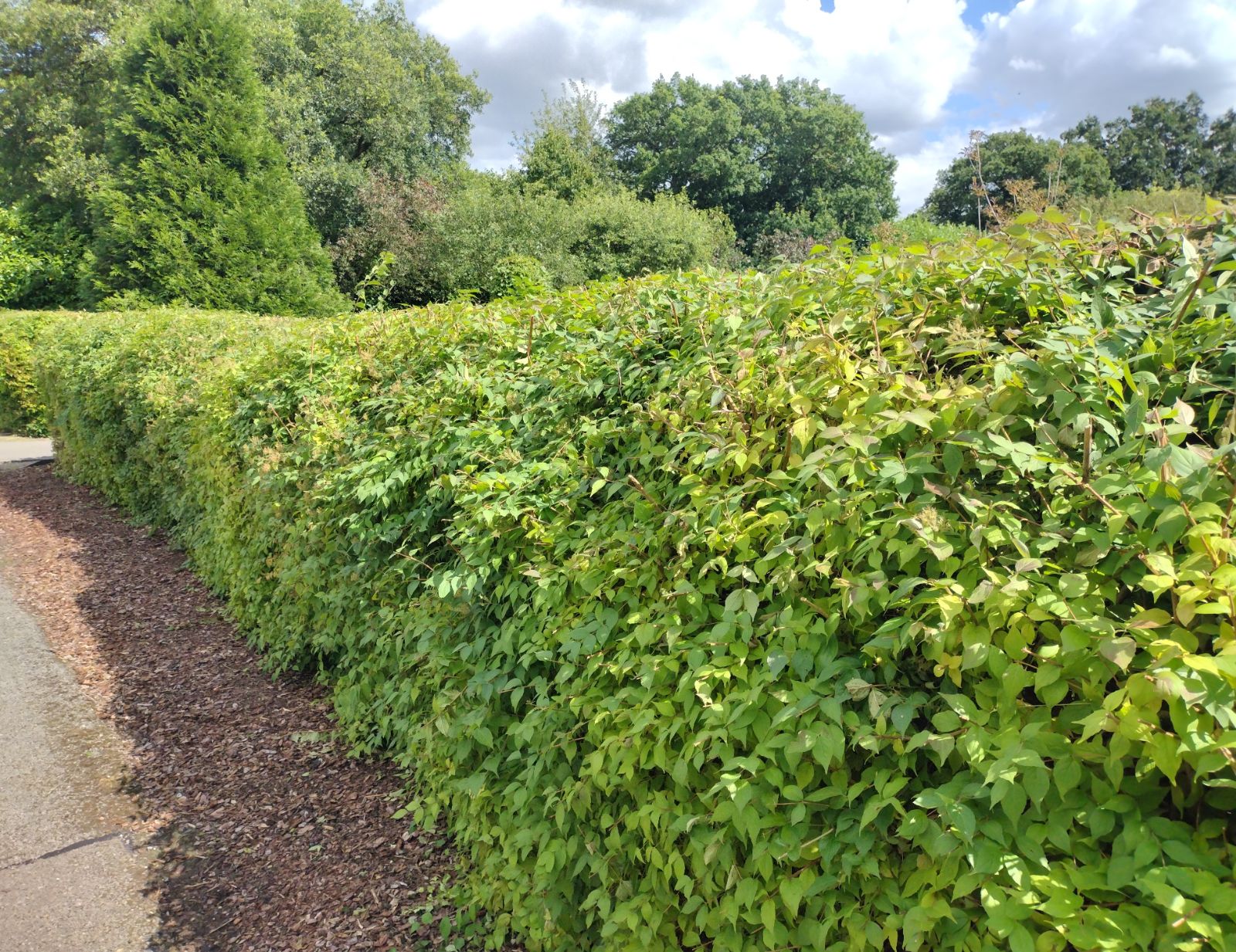Kolkwitzia amabilis
Sponsor
Kindly sponsored by
The Normanby Charitable Trust
Credits
Terry Huang (2019)
Recommended citation
Huang, T. (2019), 'Kolkwitzia amabilis' from the website Trees and Shrubs Online (treesandshrubsonline.
Deciduous shrub to 3 m tall and nearly as wide; multi-stemmed with dense, twiggy habit maturing to a vase-shape silhouette. Branchlets densely pubescent when young, light brown and smooth to rough when mature; bark peeling in large, thin sheets more towards base. Leaves opposite in two-rank arrangement, broadly ovate with rounded base and tip, 2.5–8.5 cm long and 1.5–5.5 cm wide, sparse dentation, lightly pubescent on blade and densely so on veins and margin, three to four chief veins each side of midrib, dull blue-green above, paler beneath; petioles 1–2 mm long, bristly; stipules absent. Inflorescence in panicles with short peduncles 10–15 mm long, terminating on lateral branchlets. Flowers hermaphroditic, usually paired in terminal clusters; pedicles pubescent; sepals 5, narrow, pubescent, elongating with age, persistent; corolla funnel-shaped, 1.5–2.5 cm long and as wide at mouth, petal lobes 5, rounded, with bilateral symmetry, pink to white hue, small hairs and yellow veining heaviest on lower 3 lobes, unscented; stamens 4; ovary inferior, hirsute with 3 locules, though only 1 is fertile. Fruits ovoid capsules, bristly, contain only one seed, 6.3 mm long. Flowering in May–June; fruiting August–September (China) (Graebner 1901; Bean 1981a; Krüssmann 1984; Cullen et al. 2011; Dirr 2011; Armitage et al. 2014; Flora of China 2018).
Distribution China Provinces: Anhui, Gansu, Hebei, Henan, Hubei, Shaanxi, and Shanxi. In the watershed of the Han and Yangtse rivers.
Habitat Mountain slopes, roadsides, scrub; among rocks; 300–1300 m. Rare in the wild.
USDA Hardiness Zone 4-8
RHS Hardiness Rating H6
Awards RHS Award of Merit (AM) for ‘great merit in exhibition' (in 1923).
Conservation status Not evaluated (NE)
Taxonomic note Pampanini described two varieties, K. amabilis var. calicina Pampanini, and K. amabilis var. tomentosa Pampanini, but both have long since been regarded as falling within the variation of the type.
While exploring the northwestern mountains of Ichang, Hubei, China in 1901, Ernest Henry Wilson made a collection from an unknown shrub in fruit. He noted that ‘the…plant was 5 feet…tall, had been free-flowering, with possibly red blooms, and had spinose fruits’ (Dosmann 2010). He sent his collection off to Messrs Veitch – the first time Kolkwitzia amabilis was introduced to Western cultivation – where it grew and flowered in 1910 at a nursery in Coombe Wood (Bean 1981a). It went on to become one of Wilson’s favorite introductions, given the Award of Merit for exhibition by the RHS in 1923, and its cultivar ‘Pink Cloud’ retains an Award of Garden Merit to this day.
In 1907, plants of Wilson’s original collection were sent to The Arnold Arboretum of Harvard University marking the species’ first introduction to North America (Dosmann 2010). Though the species received an Award of Merit when it was exhibited from Nymans garden, Sussex, in 1923, it would become much more popular in the United States than in the United Kingdom (Bean 1981a). Popularity and demand for Beautybush in the United States quickly grew, so much so that Wilson noted the mother plant had ‘been much mutilated for propagation purposes, and from it, either by seeds or cuttings has originated the whole stock of this plant in America’ (Dosmann 2010). Though the original plants no longer grow on the Arboretum grounds, cuttings were taken in the 1980s and two plants continue to grow in the collections: one in the Explorer’s Garden (816–84*A) and another in the Leventritt Shrub and Vine Garden (915–87*A).
While Wilson may have introduced Kolkwitzia amabilis to Western cultivation, it was Italian missionaries in China who introduced the species to Western science. Pampanini (1911) mentions both missionaries P.G. Giraldi and Fr. Silvestri collected this species twice, in 1891 and 1895, and in 1907 and 1909 respectively. As it turns out, the same year Wilson made his collection, German botanist, K.O.R.P.P. Graebner based his description of the new genus and species on P.G. Giraldi’s 1895 specimen collected on Huashan – modern eastern Shaanxi (Pampanini 1911). It is unclear if the new material has been formally studied to see how it differs from Wilson’s 1907 collection.
Despite its frequency in cultivation today, Kolkwitzia is rarely encountered in the wild. Giraldi notes on one of his specimens that the shrub is rare in the region, a sentiment echoed by Pampanini (1911) and Dosmann (2010). According to Dosmann, Western botanists did not collect seeds of this species again until 1994 when a NACPEC (North American-China Plant Exploration Consortium) expedition acquired seeds from a small population ‘about 100 miles north of Wilson’s original collection site in Hubei’ (Dosmann 2010). Germplasm of this collection was initially shared amongst the NACPEC participants – Morris Arboretum, US National Arboretum, Arnold Arboretum and Longwood Gardens – then distributed to other botanical gardens and commercial nurseries later (Del Tredici 1995; Aiello & Dosmann 2010). This suggests that prior to the 1994 expedition all material in gardens was descended from Wilson’s original collection in 1901.
While Wilson touted that ‘among the deciduous-leaved shrubs that central and western China has given to American gardens Kolkwitzia stands in the front rank’, not everyone agreed (Dosmann 2010; Dirr 2011). Some suggested it was not as beautiful as Wilson and The Arnold Arboretum lauded (Dosmann 2010), and some still feel this way today. In his Encyclopedia of Trees & Shrubs, Michael A. Dirr states that despite the lovely pink flowers in spring, the shrub ‘[u]nfortunately…offers little to excite even a passionate gardener’ (Dirr 2011). Though this may not be representative of the collective sentiment of Kolkwitzia in North America, this shrub is not in vogue today (Del Tredici 1995), which may be due to its ubiquity. Another reason may be that seedlings of poor flower color were distributed early on (Bean 1981a). The clouds of pink flowers in early summer, however, are truly beautiful and combine well with other garden plants: the double purple Rosa rugosa ‘Roseraie de l’Hay’ looks very good when clambering amongst Kolkwitzia (Bean 1981a). Old stems of Kolkwitzia develop shaggy mases of pale peeling bark and as in Heptacodium these can be a useful feature in the winter garden; it can be pruned to form a single stem if wished (Bean 1981a; Grimshaw 2019).
Nevertheless, this shrub is grown in botanical collections and domestic gardens throughout the temperate parts of the world for its beauty and ease of cultivation: Asia, Europe, North and South America, and also in New Zealand and appropriate parts of Australia. Kolkwitzia does best with regular water in well-drained soil, including chalk, in full to partial sun (Bean 1981a). However, this carefree shrub is tolerant of less than ideal situations, though it may flower less profusely. Often grown as a specimen plant where its form and spring flowers can be admired, or as a shrub for an informal hedge. Prune dead wood as needed and if thinning is desired it is best to prune soon after flowering as flowers are produced on old wood. In established plants the oldest stems should ideally removed from base every two years to allow for young shoots to develop (Bean 1981a). Vigorous young stems emering from the base are thick and heavy and may need support to avoid any snappage (Bean 1981a). It is generally unbothered by pests and diseases. Easily propagated; take greenwood cuttings in late spring or early summer or semi-ripe cuttings in early autumn and give gentle bottom-heat, or transplant suckers (Bean 1981a; Cullen et al. 2011).
'Maradco'
Synonyms / alternative names
RHS Hardiness Rating: H6
Relatively new cultivar marketed as Dream Catcher™ with ‘sunset-hued’ foliage. Leaves emerge in spring with copper tones, maturing to yellow and chartreuse along side pink flowers. In autumn, leaves turn orange and gold before dropping. Michael A. Dirr (2011) states that this is ‘a disastrous yellow-leaf calamity, perhaps worse…’ and that he and a colleague ‘…gazed upon a forlorn plant at Yew Dell Gardens in Kentucky, in June, with leaves that were toast or soon to be’. Perhaps such a state can be avoided by providing shade, at minimum, from midday onwards in hot climates. It is not so prone to scorch in the British climate but is not particularly remarkable for bright foliage either.
'Pink Cloud'
Common Names
Beautybush
RHS Hardiness Rating: H6
This cultivar was raised and selected at the RHS Garden at Wisley in 1946, from plants grown on from a seed batch received from the Morton Arboretum (Bean 1981a). It is noted for its pink flowers, which are deeper in hue than the species. It has been given an Award of Garden Merit (AGM) by the RHS.
'Rosea'
RHS Hardiness Rating: H6
‘Rosea’ is similar to ‘Pink Cloud’, but supposedly its flowers are more reddish in colour. Introduced to the trade in 1960 by Ruys of Dedemsvaart, the Netherlands. It received an RHS First Class Certificate (FCC) in 1963 for ‘outstanding excellence for exhibition’.





